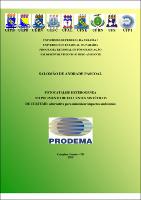| Compartilhamento |


|
Use este identificador para citar ou linkar para este item:
http://tede.bc.uepb.edu.br/jspui/handle/tede/2154| Tipo do documento: | Dissertação |
| Título: | FOTOCATÁLISE HETEROGÊNEA NO POLIMENTO DE EFLUENTES SINTÉTICOS DE CURTUME: alternativa para minimizar impactos ambientais |
| Autor: | Pascoal, Salomão de Andrade  |
| Primeiro orientador: | Sousa, José Tavares de |
| Primeiro membro da banca: | Lima, Carlos Antonio Pereira de |
| Segundo membro da banca: | Athayde Júnior, Gilson Barbosa |
| Terceiro membro da banca: | Ceballos, Beatriz Suzana Ovruski de |
| Resumo: | A indústria é um setor da sociedade contemporânea com grande potencial poluidor do meio ambiente, especialmente dos ecossistemas aquáticos. As indústrias de curtume são grandes produtoras de dejetos com significativas quantidades de material orgânico e de cromo. Os processos convencionais de tratamento aplicados a esses dejetos, nem sempre possuem boa eficácia. Atualmente, os Processos Oxidativos Avançados representam uma excelente alternativa de tratamento terciário. No presente estudo, avaliou-se a aplicação da fotocatálise heterogênea, usando-se um fotocatalisador (TiO2) imobilizado, no tratamento final de efluentes líquidos sintéticos representativos de indústrias de curtume. Objetivou-se remover Cr(VI) e matéria orgânica. O fotorreator foi do tipo Leito Fixo de Filme Fino, construído com uma placa de vidro jateado para a fixação do TiO2. Adotou-se como fontes de radiação, o sol e lâmpadas germicidas emissoras de radiação UV (l= 250 nm). Os menores valores de eficácia de remoção para Cr(VI) foram de 62% e 51% e de DQO foram de 60% e 53% para os experimentos feitos com radiação UV oriundas do sol e de lâmpadas, respectivamente. Os resultados dos parâmetros relacionados às fases de redução e oxidação da fotocatálise heterogênea, mostraram que a exposição ao sol, tem eficácia de remoção relativa maior do que a exposição à lâmpadas UV. Os dados de remoção relativa de Cr(VI) e de DQO e as constantes cinéticas destes parâmetros, indicaram que as configurações experimentais adotadas otimizaram a fase de redução da fotocatálise heterogênea. |
| Abstract: | The industry is a section of the contemporary society with great pollutant potential of the environment, especially of the aquatic ecosystems. The tanning industries are big producing of dejections with significant amounts of organic matter and of chrome. The conventional processes of treatment applied those dejections, not always they possess good effectiveness. Actuality, the Advanced Oxidation Processes represent an excellent alternative of tertiary treatment. In the present study, the application of the heterogeneous photocatalysis was evaluated, being used a photocatalyst (TiO2) immobilized, in the tertiary treatment of synthetic liquid effluents representative of tanning industries. It was aimed at to remove Cr(VI) and organic matter. The photocatalytic reactor was of the type Fixed Bed of Fine Film, built with a plate of glass arrayed for the fixation of TiO2. It was adopted as radiation sources, the sun and lamps issuing of UV radiation (l= 250 nm). The smallest values of removal effectiveness for Cr(VI) they were of 62% and 51% and of DOC they were from 60% and 53% to the experiments done with radiation UV originating from of the sun and of lamps, respectively. The results of the parameters related to the reduction phases and oxidation of the heterogeneous photocatalysis, they showed that the exhibition in the sun, he/she has effectiveness of larger relative removal than the exhibition to UV lamps. The data of relative removal of Cr(VI) and of DOC and the constants kinetics of these parameters, they indicated that the adopted experimental configurations optimized the phase of reduction of the heterogeneous photocatalysis. |
| Palavras-chave: | Fotocatálise Heterogênea Indústria de Curtume Cr(VI) Matéria Orgânica Heterogeneous Photocatalysis Tannery Industry Cr(VI) Organic Matter |
| Área(s) do CNPq: | CNPQ::ENGENHARIAS::ENGENHARIA MECANICA::ENGENHARIA TERMICA::CONTROLE AMBIENTAL |
| Idioma: | por |
| País: | BR |
| Instituição: | Universidade Estadual da Paraíba |
| Sigla da instituição: | UEPB |
| Departamento: | Gerenciamento Ambiental |
| Programa: | Programa de Pós-Graduação em Desenvolvimento e Meio Ambiente - PRODEMA |
| Citação: | PASCOAL, Salomão de Andrade. FOTOCATÁLISE HETEROGÊNEA NO POLIMENTO DE EFLUENTES SINTÉTICOS DE CURTUME: alternativa para minimizar impactos ambientais. 2006. 107 f. Dissertação (Mestrado em Gerenciamento Ambiental) - Universidade Estadual da Paraíba, Campina Grande, 2006. |
| Tipo de acesso: | Acesso Aberto |
| URI: | http://tede.bc.uepb.edu.br/tede/jspui/handle/tede/2154 |
| Data de defesa: | 23-Fev-2006 |
| Aparece nas coleções: | PRODEMA - Dissertações |
Arquivos associados a este item:
| Arquivo | Descrição | Tamanho | Formato | |
|---|---|---|---|---|
| SALOMAO_DE_ANDRADE_PASCOAL.pdf | 1.53 MB | Adobe PDF |  Baixar/Abrir Pré-Visualizar |
Os itens no repositório estão protegidos por copyright, com todos os direitos reservados, salvo quando é indicado o contrário.




